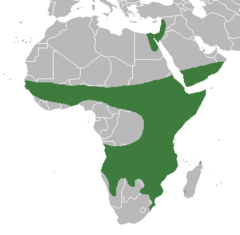Ficus sycomorus
| Ficus sycomorus | |
|---|---|
 |
|
| Scientific classification | |
| Kingdom: | Plantae |
| (unranked): | Angiosperms |
| (unranked): | Eudicots |
| (unranked): | Rosids |
| Order: | Rosales |
| Family: | Moraceae |
| Genus: | Ficus |
| Subgenus: | Sycomorus |
| Species: | F. sycomorus |
| Binomial name | |
|
Ficus sycomorus L. |
|
| Range | |
Ficus sycomorus (Bambara: Sutoro), called the sycamore fig or the fig-mulberry (because the leaves resemble those of the mulberry), sycamore, or sycomore, is a fig species that has been cultivated since ancient times.
The term sycamore spelled with an A has also been used for unrelated trees: the Great Maple, Acer pseudoplatanus, or plane trees, Platanus. The spelling "sycomore", with an O rather than an A as the second vowel is, if used, specific to Ficus sycomorus .
Ficus sycomorus is native to Africa south of the Sahel and north of the Tropic of Capricorn, also excluding the central-west rainforest areas. It also grows naturally in Lebanon, whose famous Gemmayzeh Street is derived from the tree's Arabic name, Gemmayz; in the southern Arabian Peninsula; in Cyprus; in very localized areas in Madagascar; and as a naturalised species in Israel and Egypt. In its native habitat, the tree is usually found in rich soils along rivers and in mixed woodlands.
Ficus sycomorus grows to 20 m tall and has a considerable spread as can be seen from the photograph below right, with a dense round crown of spreading branches. The leaves are heart-shaped with a round apex, 14 cm long by 10 cm wide, and arranged spirally around the twig. They are dark green above and lighter with prominent yellow veins below, and both surfaces are rough to the touch. The petiole is 0.5–3 cm long and pubescent. The fruit is a large edible fig, 2–3 cm in diameter, ripening from buff-green to yellow or red. They are borne in thick clusters on long branchlets or the leaf axil. Flowering and fruiting occurs year-round, peaking from July to December. The bark is green-yellow to orange and exfoliates in papery strips to reveal the yellow inner bark. Like all other figs, it contains a latex.
...
Wikipedia

